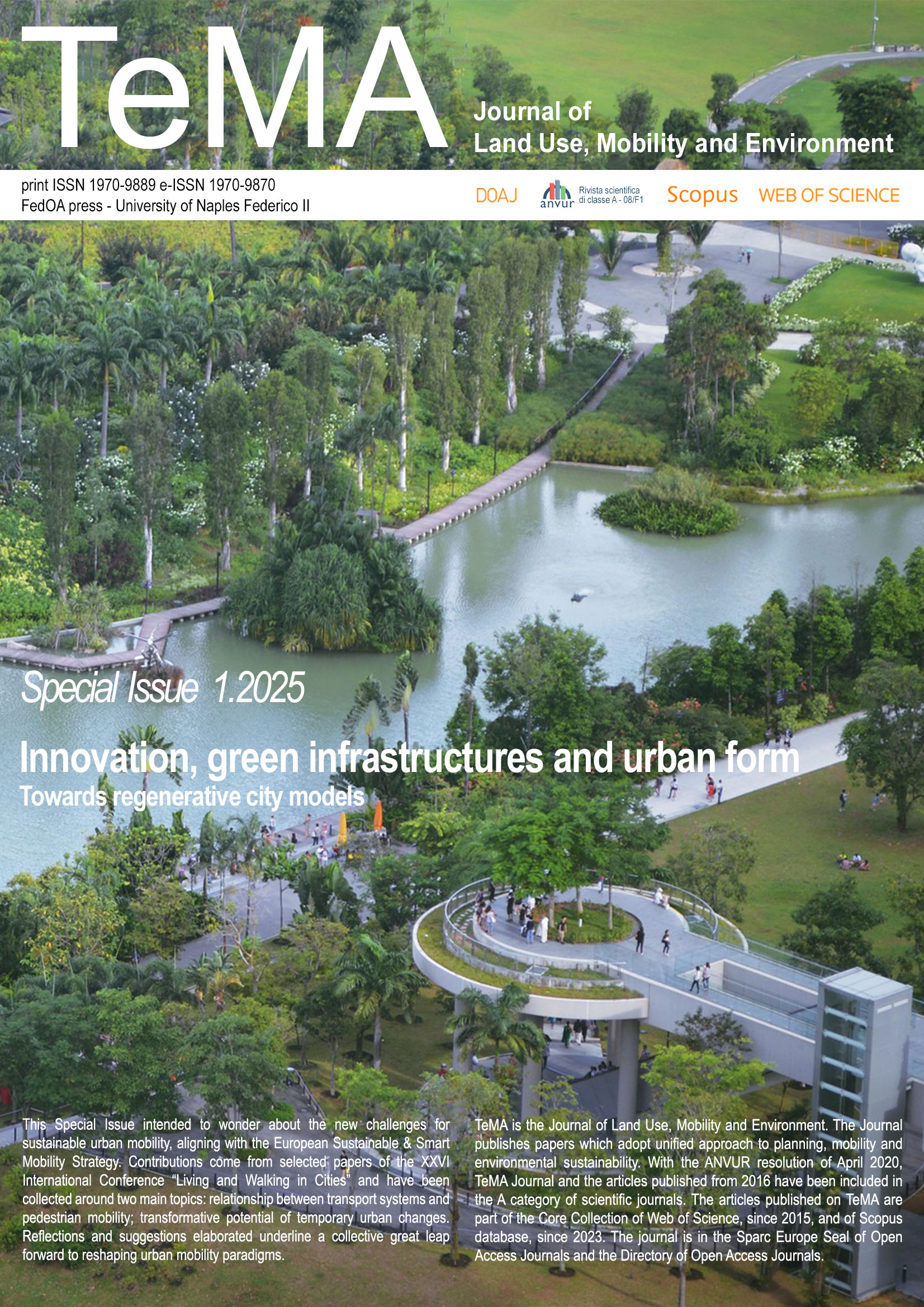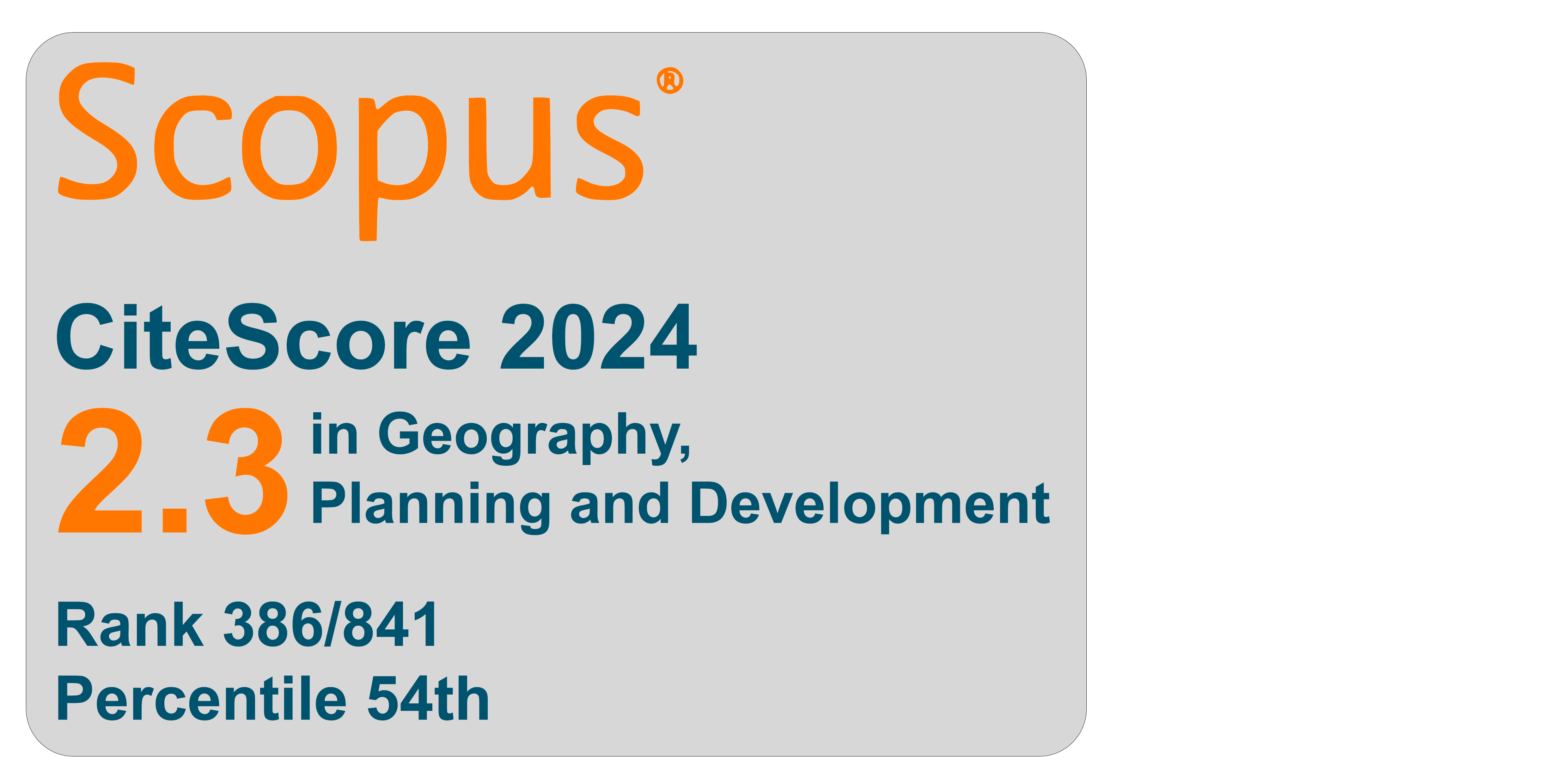Many shades of green: intrinsic and network properties of urban green areas
DOI:
https://doi.org/10.6093/1970-9870/11743Keywords:
Green public areas, Accessibility, Space Syntax, Quantitative assessment, Composite IndexAbstract
Urban green spaces are a vital component of public infrastructure, yet their evaluation often relies exclusively on either qualitative descriptions, aggregate metrics or basic quantitative thresholds. Thus, research frequently overlooks intrinsic attributes, spatial integration, functional accessibility, and the broader impact on urban liveability. This paper critically re-examines the legacy of Italy’s urban planning standards – specifically the Ministerial Decree 1444/1968, which introduced minimum green space requirements – to assess whether the prevailing metric-based paradigm has marginalized qualitative and locational dimensions. Through a comparative case study of three mid-sized Tuscan cities – Pisa, Lucca, and Grosseto – this research develops and applies an original methodology that integrates both intrinsic characteristics (typological, geometric, and structural) and extrinsic features (accessibility and configurational properties) of urban green spaces. Drawing on field surveys, spatial analysis, and Space Syntax techniques, the study constructs a composite evaluative framework to assess the actual usability and functional performance of green areas within the urban context. Findings reveal that a substantial proportion of green spaces are either residual or inaccessible, and are often poorly connected to the urban fabric despite formal compliance with legal standards. While national planning requirements have increased the quantity of public green space, these areas are frequently located on the urban periphery or insufficiently integrated into movement networks, thereby limiting their effectiveness. The proposed approach offers a lightweight yet robust tool for quali-quantitative assessment, enabling more nuanced evaluations and supporting context-sensitive planning practices. The study advocates for a renewed emphasis on design quality and locational integration in green infrastructure policies to enhance the equity, usability, and liveability of urban environments.
Downloads
References
Aronson, M. F., Lepczyk, C. A., Evans, K. L., Goddard, M. A., Lerman, S. B., MacIvor, J. S., ... & Vargo, T. (2017). Biodiversity in the city: key challenges for urban green space management. Frontiers in Ecology and the Environment, 15(4), 189-196. https://doi.org/10.1002/fee.1480
Biernacka, M., & Kronenberg, J. (2018). Classification of institutional barriers affecting the availability, accessibility and attractiveness of urban green spaces. Urban Forestry & Urban Greening, 36, 22-33. https://doi.org/10.1016/j.ufug.2018.10.001
Bocca, A. (2024). Sustainable development and proximity city. The environmental role of new public spaces. TeMA - Journal of Land Use, Mobility and Environment, 17(1), 71-87. https://doi.org/10.6092/1970-9870/3649
C.N.R. (1946). Manuale dell'architetto. Roma: U.S.I.S. (Ufficio Informazioni Stati Uniti).
Ceci, M., Caselli, B., & Zazzi, M. (2023). Soil de-sealing for cities' adaptation to climate change. TeMA - Journal of Land Use, Mobility and Environment, 16(1), 121-145. https://doi.org/10.6092/1970-9870/3649
Cutini, V. (2016). La forma del disordine: Tecniche di analisi e progetto urbano ai tempi dello sprawl (pp. 1-226). Mimesis Edizioni.
Dodi, L. (1953). Elementi di urbanistica. Milano: Tamburini edizioni.
Farkhondeh, A., Fateminia, M., & Hosseingholipour, Z. (2023). The Space Syntax of urban parks; identifying areas inducing sense of fear of crime in visitors (a case study of Tappeh-Bashi Park in Naghadeh). Journal of Fine Arts: Visual Arts, 28(4), 157-170. https://doi.org/10.6092/1970-9870/3649
Giannakidou, A., & Latinopoulos, D. (2023). Identifying spatial variation in the values of urban green at the city level. TeMA - Journal of Land Use, Mobility and Environment, 16(1), 83-104. https://doi.org/10.6092/1970-9870/3649
Gomaa, M. M., Ullah, U., & Mehr Afroz, Z. (2024). The Impact of Spatial Configuration on Perceived Accessibility of Urban Parks based on Space Syntax and Users' Responses. Civil Engineering and Architecture, 12, 2395-2402. https://doi.org/10.6092/1970-9870/3649
Haaland, C., & van Den Bosch, C. K. (2015). Challenges and strategies for urban green-space planning in cities undergoing densification: A review. Urban Forestry & Urban Greening, 14(4), 760-771. https://doi.org/10.1016/j.ufug.2015.07.006
Hillier, B. (2007). Space is the machine: a configurational theory of architecture. Space Syntax.
Huang, B. X., Li, W. Y., Ma, W. J., & Xiao, H. (2023). Space accessibility and equity of urban green space. Land, 12(4), 766. https://doi.org/10.3390/land12040766
Isola, F., Leone, F., & Pittau, R. (2023). Evaluating the urban heat island phenomenon from a spatial planning viewpoint. A systematic review. TeMA - Journal of Land Use, Mobility and Environment, 75-93. https://doi.org/10.6092/1970-9870/3649
Kabisch, N., Qureshi, S., & Haase, D. (2015). Human–environment interactions in urban green spaces—A systematic review of contemporary issues and prospects for future research. Environmental Impact Assessment Review, 50, 25-34. https://doi.org/10.1016/j.eiar.2014.08.007
Karimi, K. (2012). A configurational approach to analytical urban design:‘Space syntax’methodology. Urban Design International, 17(4), 297-318. https://doi.org/10.1057/udi.2012.19
Lazzarini, L., Mahmoud, I. H., & Pastore, M. C. (2024). Urban planning for biodiversity. An assessment of green plans in Northern Italy. TeMA - Journal of Land Use, Mobility and Environment, 1, 45-60. https://doi.org/10.6092/1970-9870/3649
Li, F., Wang, R., Paulussen, J., & Liu, X. (2005). Comprehensive concept planning of urban greening based on ecological principles: a case study in Beijing, China. Landscape and Urban Planning, 72(4), 325-336. https://doi.org/10.1016/j.landurbplan.2004.04.002
Li, X., Ni, G., & Dewancker, B. (2019). Improving the attractiveness and accessibility of campus green space for developing a sustainable university environment. Environmental Science and Pollution Research, 26, 33399-33415. https://doi.org/10.1007/s11356-019-06520-7
Nowak, D. J., & Greenfield, E. J. (2012). Tree and impervious cover change in US cities. Urban Forestry & Urban Greening, 11(1), 21-30. https://doi.org/10.1016/j.ufug.2011.11.005
Pantaloni, M., Botticini, F., & Marinelli, G. (2024). Assessment of urban green spaces proximity to develop the green infrastructure strategy. An Italian case study. TeMA - Journal of Land Use, Mobility and Environment, 3, 67-81. https://doi.org/10.6092/1970-9870/3649
Piccinato, L. (1947). Urbanistica. Roma: Sandron.
Regione Toscana (2019). Direzione Urbanistica e Politiche Abitative - Sistema Informativo Territoriale e Ambientale – SITA.: Carte Tecniche Regionali.
Rigolon, A. (2016). A complex landscape of inequity in access to urban parks: A literature review. Landscape and Urban Planning, 153, 160-169. https://doi.org/10.1016/j.landurbplan.2016.05.017
Rigotti, G. (1947). Urbanistica. La tecnica. Torino: Utet.
Salzano, E. (2017). Standard Urbanistici D.M.1444/68: #DiscussioniUrbane con Edoardo Salzano & Andrea Pantaleo. URL https://www.youtube.com/watch?v=3JgC3ysDUok
Tannous, H. O., Major, M. D., & Furlan, R. (2021). Accessibility of green spaces in a metropolitan network using space syntax to objectively evaluate the spatial locations of parks and promenades in Doha, State of Qatar. Urban Forestry & Urban Greening, 58, 126892. https://doi.org/10.1016/j.ufug.2021.126892
Tedeschi, E. (1947). Dimensionamento dei servizi negli abitati. Metron, 16, 55-70 e 17, 38-64.
Turner, A. (2007). From axial to road-centre lines: a new representation for space syntax and a new model of route choice for transport network analysis. Environment and Planning B: Planning and Design, 34(3), 539-555. https://doi.org/10.1068/b32067
United Nations World Cities Report. (2022). Envisaging the future of cities. Nairobi, Kenya: UN Habitat. Unhabitat.org
Van Nes, A., & Yamu, C. (2021). Introduction to space syntax in urban studies (p. 250). Springer Nature.
Wang, F., Chen, J., Tong, S., Zheng, X., & Ji, X. (2022). Construction and optimization of green infrastructure network based on space syntax: A case study of Suining County, Jiangsu Province. Sustainability, 14(13), 7732. https://doi.org/10.3390/su14137732
Wolch, J. R., Byrne, J., & Newell, J. P. (2014). Urban green space, public health, and environmental justice: The challenge of making cities ‘just green enough’. Landscape and Urban Planning, 125, 234-244. https://doi.org/10.1016/j.landurbplan.2014.01.017
Zhang, R., Zhang, C. Q., & Rhodes, R. E. (2021). The pathways linking objectively-measured greenspace exposure and mental health: A systematic review of observational studies. Environmental Research, 198, 111233. https://doi.org/10.1016/j.envres.2021.111233.
Downloads
Published
How to Cite
Issue
Section
License
Copyright (c) 2025 TeMA - Journal of Land Use, Mobility and Environment

This work is licensed under a Creative Commons Attribution 4.0 International License.
Authors who publish in this journal agree to the following:
1. Authors retain the rights to their work and give in to the journal the right of first publication of the work simultaneously licensed under a Creative Commons License - Attribution that allows others to share the work indicating the authorship and the initial publication in this journal.
2. Authors can adhere to other agreements of non-exclusive license for the distribution of the published version of the work (ex. To deposit it in an institutional repository or to publish it in a monography), provided to indicate that the document was first published in this journal.
3. Authors can distribute their work online (ex. In institutional repositories or in their website) prior to and during the submission process, as it can lead to productive exchanges and it can increase the quotations of the published work (See The Effect of Open Access)



